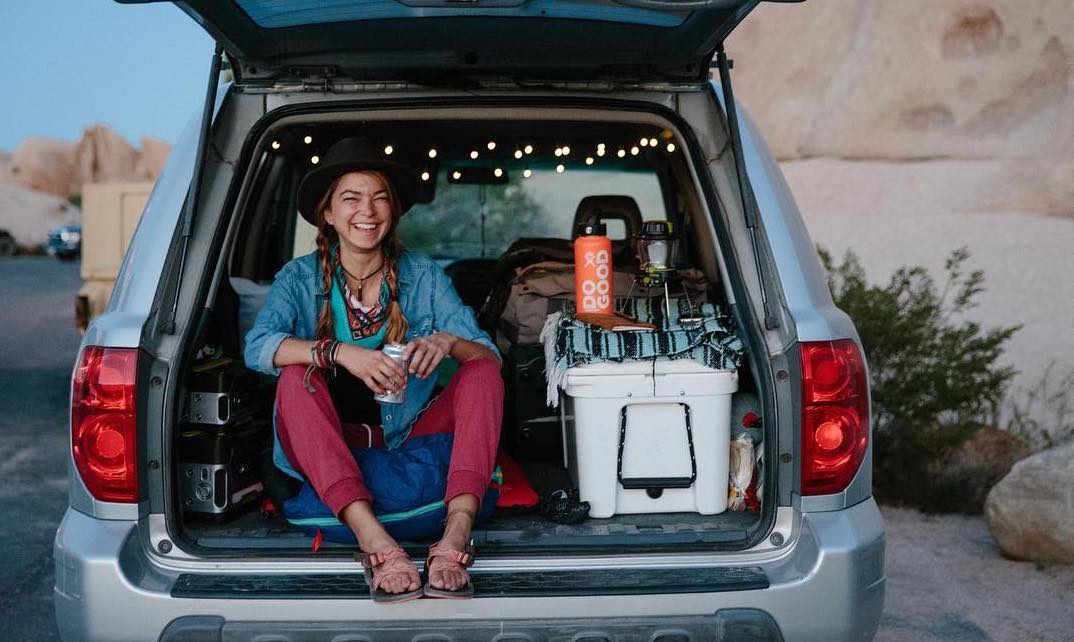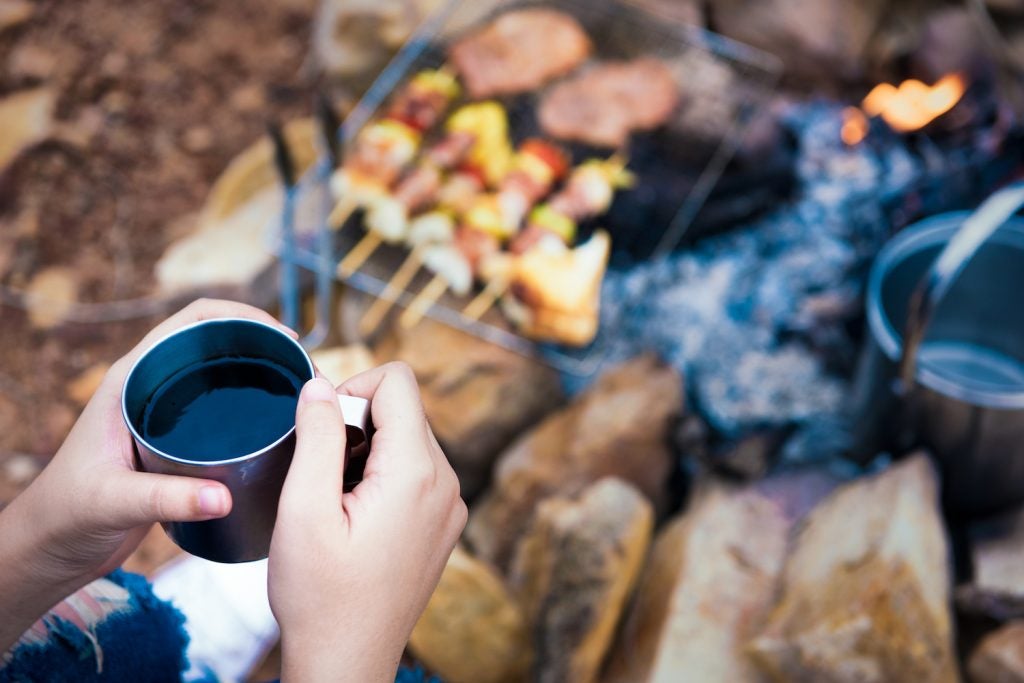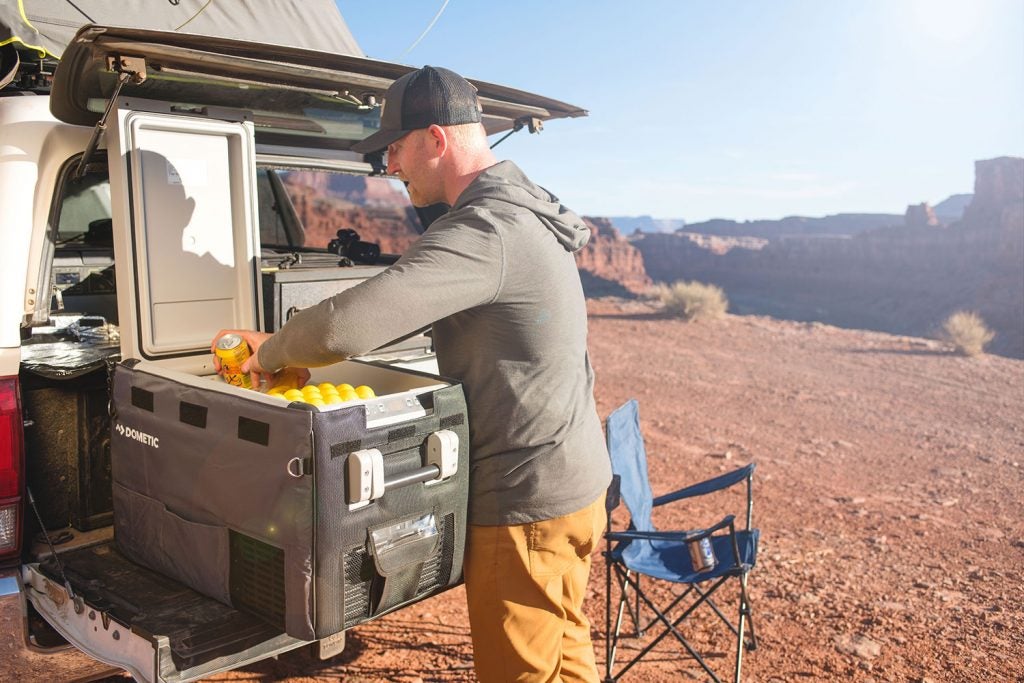In 2013, Katie Boué bought a bright yellow van and hit the road. The rest, you could say, is history. Katie fell in love with the American West and decided to make Salt Lake City, UT her home base where she continues to advocate for public lands and the outdoor recreation economy. On her website, The Morning Fresh, Katie talks about climbing, life on the road, and of course, adventuring.
If you follow her on Instagram, you know all about her recently adopted pup, Spaghetti (or Sketti, for short), the effect of CBD oil on physical and mental health, and the importance of LNT on all your desert or mountain adventures. She actively protests land mismanagement and travels to DC to take part in events like Climb the Hill.
With all she’s doing to promote and protect public lands (specifically standing alongside Native American allies, since the land was originally Native owned), she’s humble first and foremost.
Meet Katie Boué: Public Lands Activist, Writer at The Morning Fresh
We caught up with Katie of The Morning Fresh to dig a little deeper into her lifestyle. Turns out, she’s as cool as she looks on Instagram.
The Dyrt: Can you tell us a little more about how your passion for public lands progressed?
Katie Boué: Public lands have always been a big part of my life, whether consciously or not. I started becoming aware of the concept of public lands and the outdoors in college when I started climbing at Tallahassee Rock Gym, but it didn’t solidify as a definitive force in my life until I started working at the Outdoor Industry Association. I took a part-time job running their then-barely-existing social media platforms, turned it into a full-time job, and through my work at OIA found the world of outdoor recreation policy. Over the last four years, it became what I live for.
[bctt tweet=”When people think “I want to do that,” it isn’t a stroke for my ego, it’s a reminder to be a role model and keep doing good. – @katieboue” username=”thedyrt”]
You’ve traveled in a van across the country. Do you feel like the vanlife movement is affecting our outdoor spaces? If so, how? If not, why?
My partner and I just got a new van, so I have been reckoning with what it means to be rejoining the #vanlife, ha! I think the growth of the vanlife movement is a space where we need to accept and embrace what’s happening, and do something good with it.
Yes, dispersed campsites are getting more crowded. Yes, it’s totally a little satisfying to roll your eyes at vanlifers. But also, every single one of those vanlife people has the potential to become an active outdoor advocate. Van-livers need a place to park. What if parks started offering free camping in exchange for conservation and trail work? There’s opportunity here.
People, especially like us at The Dyrt, see your Instagram profile and think: “I want to be / do that.” How do you manage that pressure?
I try not to let myself even think thoughts like “people see my Instagram and want to be like me.” It’s a bizarre thing to put your life on the internet, and I think the key to doing it without losing your mind is a constant flow of humility.
I am not that cool, I just happened to be good at sharing my life on social media. There are so many folks out there climbing bigger mountains, doing more on-the-ground work for public lands, making more significant impacts than I am–and I try to keep my self-pressure focused on that. When people think “I want to do that,” it isn’t a stroke for my ego, it’s a reminder to be a role model and keep doing good.
What do you say to people who want your lifestyle?
Get after it! Grab a journal, go sit outside somewhere, and write down what you want in life. Make a plan for it. Put that plan in motion. Through a mix of privilege, hard work, luck, blind ambition, and being exceptionally talented at faking-it-til-you-make-it, I came into this lifestyle–which is really just a nice way of saying “my messy, wonderful, joyous little life I somehow pushed into existence.”
You’ve mentioned dealing with anxiety in your Instagram stories and photos. As someone who lives with anxiety, I know how hard it can be to sustain an active and pro-active lifestyle. What does a typical day look like for you when you’re facing anxiety head-on?
First of all, I love that our outdoor adventure community is starting to talk about mental health so regularly! Sometimes, my icky anxiety day is me dealing with those chest fluttering, belly aching blues by doing as much as I can to ‘accomplish something’ that day before resigning to just laying low.
Other days, it’s a total wreck from sunrise to sunset with me just trying to stay afloat. There’s a lot of time spent hiding under a blanket on my couch just trying to continue to exist. I have been testing out hemp CBD treatments, which have significantly helped me deal with anxiety day-to-day.
What advice would you give to other awesome humans who face similar struggles?
Try breathing exercises and hemp CBD. Both changed my life. That, and starting to go to yoga regularly.
If your anxiety is really rearing its ugliness, remember that it’s okay to spend the entire day in bed drinking La Croix and watching Grace & Frankie. You’re still great and worthy, and tomorrow is another day to try again.
How do you balance eschewing geo-tagging with inspiring more people to get outside?
Geo-tagging is such a complicated topic, and I’m looking forward to continuing more conversations about it. I think that cutting back or eliminating the use of geo-tagging is having a loud moment, but that ultimately it will just become a thing we do (or rather, don’t). I can still spread a loud and proud message of “get out there and explore your public lands!” without specifically tagging certain sensitive locations. Right now, we’re making a big deal about stopping geo-tags, so it’s more in your face. Once the hubbub dies down and we shift away from using geo-tags as much, I don’t think it’ll feel quite so aggressive. It’ll still be beautiful photos of public lands and the outdoors, it just won’t have a pinpointed map attached anymore.
In place of geo-tags, I’d like to see outdoor education on LNT and stewardship become the new cool thing to attach to our public lands images.
[bctt tweet=”Grab a journal, go sit outside somewhere, and write down what you want in life. Make a plan for it. Put that plan in motion.” username=”katieboue”]
As a social media professional, you have to be conscious of your brand on platforms like Instagram. Do you think there’s a gap between your real-life personality and the personal brand you present on social media? Or do you feel free to completely be yourself on Instagram?
I try to keep it as real as possible on social media. Authenticity is important for building your brand, but also for not perpetuating glamorized ideas of humans. I don’t want to send a fake message of perfection to my audience–especially those above mentioned people who “want to be like me.” If I’m going to be a role model, I want people to look up to a real, messy, flawed person.
I do curse significantly more in real life than on social media, though. It’s a naughty Miami habit.
Florida to the Rocky Mountain West is quite the shift in lifestyle. How did you adjust? Will you ever go back?
I will never, ever live in Florida ever again. I love to go home, I love to visit and explore my old state–but once you get a taste of the mountains, there’s no turning back.
What are some principles you live by when recreating and camping on public land?
- Tread as dang lightly as you can.
- Always pick up one piece of trash, every time you go outside.
- Also every time you go outside: take a minute to close your eyes and really feel the earth around you, and be grateful as hell.
- If you ask yourself “am I doing something bad/wrong/harmful?” the answer is probably leaning towards yes, so just don’t do it.
- Produce peels are still litter.
- Something I learned from my dear friend Len Necefer: If you take something from nature, give something back to it.
Our readers are avid campers, some spending 100+ nights outside every year. What are some small ways they can give back to the campgrounds, BLM land, and Forest Service roads they often inhabit?
One of the easiest things you can do to give back is to treat it like your home. Pick up trash around your yard. Invite your neighbors to do the same. Live by the above-mentioned principles. And sign up for a trail day every once in a while! Pay your rent by serving your public lands.
[bctt tweet=”Public lands are for the people, and need to be protected. And most importantly: public land is Native land.” – @katieboue username=”TheDyrt”]
Do you ever get exhausted with social media?
Always. It’s my job and my livelihood, but it also burns folks out so fast, and I’m weary of that. I banned my iPhone from my bedroom to remove one layer of daily interaction with it, and it’s made me so much happier. I also just moved all my social apps to a folder on the second home page of my iPhone. I want to get more intentional and effective with the time I spend on social media. It’s an empowering, educational, incredible tool, but it can also be toxic to the individual.
How many hours a day do you spend on social platforms for work and pleasure?
Too many.
You spend a lot of time advocating for Utah and public land across the country in DC and at home. Do you think there’s anything cut-and-dry about public land? How complicated is the debate over how to use public spaces?
The debate over how to use public spaces is c-o-m-p-l-i-c-a-t-e-d and on some of these issues, I don’t see a definitive solution in sight. But one thing remains steadfast: public lands are for the people, and need to be protected. And most importantly: public land is Native land.
[bctt tweet=”If you ask yourself “am I doing something bad/wrong/harmful?” the answer is probably leaning towards yes, so just don’t do it.” username=”katieboue”]
If you could lay out a roadmap for becoming more knowledgeable in the public land debate, what would that look like? What would the reading/newsletter list include?
The first assignment would be to get out on public lands. To know and love and experience these places is to develop a true sense of why it’s so important to get involved. Next, you need to discover how to get involved locally. We all have public lands in our own backyards that need protecting. Seek out local non-profits and environmental groups, and start devouring information.
A few musts on my reading list:
- Everything Outdoor Alliance posts on their blog. OA’s blog is timely, relevant, resourceful, and breaks down the latest public lands issues in a digestible way.
- Dispossessing the Wilderness: Indian Removal and the Making of the National Parks: A powerful, uncomfortable, must-read book that explains the history of colonization of public lands. In today’s public land conversations, an informed perspective on Indigenous history is mandatory.
- Listen to Episode 71 of the She-Explores podcast about outdoor advocacy, then listen to my She-Explores interview about finding your voice to speak for public land.
You can follow Katie from The Hill to the hills (and the mountains) on her Instagram account, @KatieBoue and on her website, The Morning Fresh.



